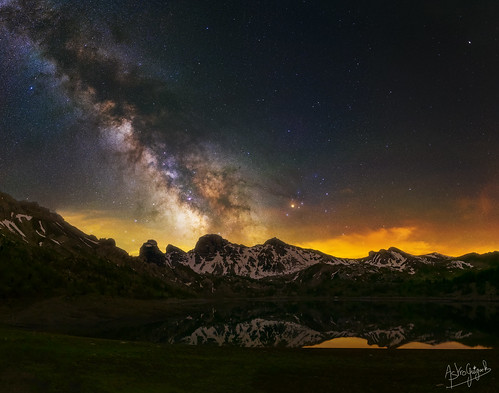Lights from ... our Galaxy
If I had to choose a single image of my trip under the Chilean sky, it would be this 1-minute-exposure wide-field view of the Milky Way. Why? Simply because of its emotional aspect: I had never seen the southern sky before that date, when I captured the picture back in May 2018.
It was taken from 2 000 meters altitude, in the heart of the Chilean Andes, in the Coquimbo Region. Indeed, that night was the first one in my life I observed the southern starry sly from a remote dark location. The sky was absolutely mind-blowing! The most amazing night sky I have ever seen in my life.
The emotional effect coming from this image is still there today.
To illustrate my words, I can describe you how did the sky look like, as closest as possible to what it really was. The darkness of the night was so intense, that both the stars and the Milky Way itself illuminated the landscape around me, so that I did not need any torch lamp or red light to enhance my night vision. To the naked eye, the galactic bulge seemed to be a shining "daytime" cloud, and the Milky Way was hanging over me like a slightly underexposed black and white picture. Planets Mars and Jupiter were so bright they were starting to disrupt the observation of the Milky Way! (I put my hand in front of them to better enjoy the sky, like we used to do when the Sun is disturbing the observation of a landscape).
Airglow, this peculiar physical phenomenon producing an orange light glow in the sky was heavily present that night. Moreover, we can easily inspect its effect on the picture: the background sky is not black or homogeneous as it should be. We can notice a veil in the darker parts of the image (at the bottom left) and on the upper part of the galactic bulge. In fact, Airglow is what gives an overall orange tint to this wide-field image. What we could consider as a natural source of light pollution.
Even though this view is a single 1 minute exposure, a high amount of celestial objects can be found. The most famous nebulae like Laguna, Trifid, Rho Ophiuchi, Omega, Cat's paw or even stellar clusters such as M7, M25 and the great Sagittarius cluster ...
I hope this deep dive in the darkness of our Galaxy will make you dreaming.
It was taken from 2 000 meters altitude, in the heart of the Chilean Andes, in the Coquimbo Region. Indeed, that night was the first one in my life I observed the southern starry sly from a remote dark location. The sky was absolutely mind-blowing! The most amazing night sky I have ever seen in my life.
The emotional effect coming from this image is still there today.
To illustrate my words, I can describe you how did the sky look like, as closest as possible to what it really was. The darkness of the night was so intense, that both the stars and the Milky Way itself illuminated the landscape around me, so that I did not need any torch lamp or red light to enhance my night vision. To the naked eye, the galactic bulge seemed to be a shining "daytime" cloud, and the Milky Way was hanging over me like a slightly underexposed black and white picture. Planets Mars and Jupiter were so bright they were starting to disrupt the observation of the Milky Way! (I put my hand in front of them to better enjoy the sky, like we used to do when the Sun is disturbing the observation of a landscape).
Airglow, this peculiar physical phenomenon producing an orange light glow in the sky was heavily present that night. Moreover, we can easily inspect its effect on the picture: the background sky is not black or homogeneous as it should be. We can notice a veil in the darker parts of the image (at the bottom left) and on the upper part of the galactic bulge. In fact, Airglow is what gives an overall orange tint to this wide-field image. What we could consider as a natural source of light pollution.
Even though this view is a single 1 minute exposure, a high amount of celestial objects can be found. The most famous nebulae like Laguna, Trifid, Rho Ophiuchi, Omega, Cat's paw or even stellar clusters such as M7, M25 and the great Sagittarius cluster ...
I hope this deep dive in the darkness of our Galaxy will make you dreaming.
Technical Details....
Canon Rebel T5i + Sigma Art 18-35mm f/1.8 lens + Star Adventurer MINI star tracker
→ Single 60 seconds exposure
→ ISO 3200
→ 18 mm
→ f/1.8
→ Single 60 seconds exposure
→ ISO 3200
→ 18 mm
→ f/1.8





![Compilation of Green & Blue Flashes, Sunset Mirages from Chile [Images + Videos]](https://blogger.googleusercontent.com/img/b/R29vZ2xl/AVvXsEhvWulXkQrf3Gsdj-5gSd9h6k49y0Z-9mEQ4NEw67R7BWJ56X7VeIcEqqG_qelRCaIJSqIkJfJ5UgL_WmqerIwYmPRXb9YYcnEf9u3bQrn-hIZhiix0e-MOO38YRqRM64ocpeZUv4wHSGg/s72-c/100_portraits_of_our_sun_guillaume_doyen_share.jpg)

No comments:
Post a Comment
Feel free to drop me a comment!